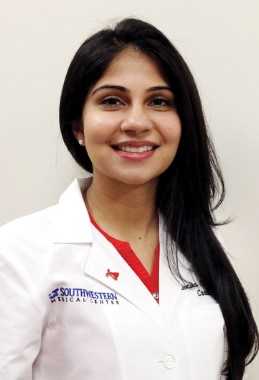User login
The number of children a woman has may affect her future risk of cardiovascular disease – and the mechanism may be subclinical atherosclerosis, data from the Dallas Heart Study suggest.
Women who had had two or three live births had the lowest prevalence of subclinical atherosclerosis, compared with women who had four or more children and with women who had no live births or one live birth, depicting "a U-shaped association between the number of children a woman gives birth to and future risk of cardiovascular events," said Dr. Monika Sanghavi, chief cardiology fellow at the University of Texas Southwestern Medical Center, Dallas.
Dr. Sanghavi summarized the study results in a webcast held prior to the annual meeting of the American College of Cardiology, where she is presenting the data.
The number of children women have has been associated with their future cardiovascular disease risk, but the mechanism has not been clearly understood. For this study of 1,644 women enrolled in the Dallas Heart Study the researchers addressed whether the mechanism could be subclinical atherosclerosis by using coronary artery calcium (CAC) scores measured with CT imaging and aortic wall thickness (AWT) measured with magnetic resonance imaging. The average age of the women was 45 years, and 55% were black.
The Dallas Heart Study is a multiethnic population–based sample of Dallas County residents.
CAC scores were positive (greater than 10) in 11% of the women who had 2-3 live births, compared with 27% in those who had at least 4 live births, and 15% of those who had 0-1 live births, all significant differences.
AWTs were abnormal (greater than the 75th percentile for age and gender) in 22% of those with had 2-3 live births, compared with 33% of those who had at least 4 live births and 25% of those who had 0-1 live births. The association persisted after adjustment for cardiovascular disease risk factors, including socioeconomic status, race and education.
"The results support the hypothesis that subclinical atherosclerosis may be the mechanism for this association," Dr. Sanghavi said. As for the two groups identified at risk, she added, "we think that increased risk on either end of the curve likely represents two different processes, such that repeated pregnancies increase risk in a different way than those women who are unable to get pregnant."
These results need to be confirmed in future studies, which will also further explore why women with one or no live births are at increased risk, Dr. Sanghavi said. Those with four or more live births may be at increased risk because of "repeated exposure to an atherogenic milieu," with higher cholesterol levels, insulin resistance and other pregnancy-related changes, or factors not accounted for in the study, she noted.
But women with 0-1 live births may be at increased risk because of an underlying systemic condition such as polycystic ovarian syndrome "or some other inflammatory condition that is preventing them from getting pregnant or carrying multiple pregnancies to term," she added.
Dr. Sanghavi emphasized that the results should not be used to recommend that women should have two or three children.
Dr. Vera Bittner, chair of the ACC Prevention of Cardiovascular Disease Committee, said the results highlight the need to take "a better reproductive history when we’re trying to judge a woman’s cardiovascular risk when they present to our office."
Dr. Sanghavi had no disclosures.
The number of children a woman has may affect her future risk of cardiovascular disease – and the mechanism may be subclinical atherosclerosis, data from the Dallas Heart Study suggest.
Women who had had two or three live births had the lowest prevalence of subclinical atherosclerosis, compared with women who had four or more children and with women who had no live births or one live birth, depicting "a U-shaped association between the number of children a woman gives birth to and future risk of cardiovascular events," said Dr. Monika Sanghavi, chief cardiology fellow at the University of Texas Southwestern Medical Center, Dallas.
Dr. Sanghavi summarized the study results in a webcast held prior to the annual meeting of the American College of Cardiology, where she is presenting the data.
The number of children women have has been associated with their future cardiovascular disease risk, but the mechanism has not been clearly understood. For this study of 1,644 women enrolled in the Dallas Heart Study the researchers addressed whether the mechanism could be subclinical atherosclerosis by using coronary artery calcium (CAC) scores measured with CT imaging and aortic wall thickness (AWT) measured with magnetic resonance imaging. The average age of the women was 45 years, and 55% were black.
The Dallas Heart Study is a multiethnic population–based sample of Dallas County residents.
CAC scores were positive (greater than 10) in 11% of the women who had 2-3 live births, compared with 27% in those who had at least 4 live births, and 15% of those who had 0-1 live births, all significant differences.
AWTs were abnormal (greater than the 75th percentile for age and gender) in 22% of those with had 2-3 live births, compared with 33% of those who had at least 4 live births and 25% of those who had 0-1 live births. The association persisted after adjustment for cardiovascular disease risk factors, including socioeconomic status, race and education.
"The results support the hypothesis that subclinical atherosclerosis may be the mechanism for this association," Dr. Sanghavi said. As for the two groups identified at risk, she added, "we think that increased risk on either end of the curve likely represents two different processes, such that repeated pregnancies increase risk in a different way than those women who are unable to get pregnant."
These results need to be confirmed in future studies, which will also further explore why women with one or no live births are at increased risk, Dr. Sanghavi said. Those with four or more live births may be at increased risk because of "repeated exposure to an atherogenic milieu," with higher cholesterol levels, insulin resistance and other pregnancy-related changes, or factors not accounted for in the study, she noted.
But women with 0-1 live births may be at increased risk because of an underlying systemic condition such as polycystic ovarian syndrome "or some other inflammatory condition that is preventing them from getting pregnant or carrying multiple pregnancies to term," she added.
Dr. Sanghavi emphasized that the results should not be used to recommend that women should have two or three children.
Dr. Vera Bittner, chair of the ACC Prevention of Cardiovascular Disease Committee, said the results highlight the need to take "a better reproductive history when we’re trying to judge a woman’s cardiovascular risk when they present to our office."
Dr. Sanghavi had no disclosures.
The number of children a woman has may affect her future risk of cardiovascular disease – and the mechanism may be subclinical atherosclerosis, data from the Dallas Heart Study suggest.
Women who had had two or three live births had the lowest prevalence of subclinical atherosclerosis, compared with women who had four or more children and with women who had no live births or one live birth, depicting "a U-shaped association between the number of children a woman gives birth to and future risk of cardiovascular events," said Dr. Monika Sanghavi, chief cardiology fellow at the University of Texas Southwestern Medical Center, Dallas.
Dr. Sanghavi summarized the study results in a webcast held prior to the annual meeting of the American College of Cardiology, where she is presenting the data.
The number of children women have has been associated with their future cardiovascular disease risk, but the mechanism has not been clearly understood. For this study of 1,644 women enrolled in the Dallas Heart Study the researchers addressed whether the mechanism could be subclinical atherosclerosis by using coronary artery calcium (CAC) scores measured with CT imaging and aortic wall thickness (AWT) measured with magnetic resonance imaging. The average age of the women was 45 years, and 55% were black.
The Dallas Heart Study is a multiethnic population–based sample of Dallas County residents.
CAC scores were positive (greater than 10) in 11% of the women who had 2-3 live births, compared with 27% in those who had at least 4 live births, and 15% of those who had 0-1 live births, all significant differences.
AWTs were abnormal (greater than the 75th percentile for age and gender) in 22% of those with had 2-3 live births, compared with 33% of those who had at least 4 live births and 25% of those who had 0-1 live births. The association persisted after adjustment for cardiovascular disease risk factors, including socioeconomic status, race and education.
"The results support the hypothesis that subclinical atherosclerosis may be the mechanism for this association," Dr. Sanghavi said. As for the two groups identified at risk, she added, "we think that increased risk on either end of the curve likely represents two different processes, such that repeated pregnancies increase risk in a different way than those women who are unable to get pregnant."
These results need to be confirmed in future studies, which will also further explore why women with one or no live births are at increased risk, Dr. Sanghavi said. Those with four or more live births may be at increased risk because of "repeated exposure to an atherogenic milieu," with higher cholesterol levels, insulin resistance and other pregnancy-related changes, or factors not accounted for in the study, she noted.
But women with 0-1 live births may be at increased risk because of an underlying systemic condition such as polycystic ovarian syndrome "or some other inflammatory condition that is preventing them from getting pregnant or carrying multiple pregnancies to term," she added.
Dr. Sanghavi emphasized that the results should not be used to recommend that women should have two or three children.
Dr. Vera Bittner, chair of the ACC Prevention of Cardiovascular Disease Committee, said the results highlight the need to take "a better reproductive history when we’re trying to judge a woman’s cardiovascular risk when they present to our office."
Dr. Sanghavi had no disclosures.
FROM ACC.14

